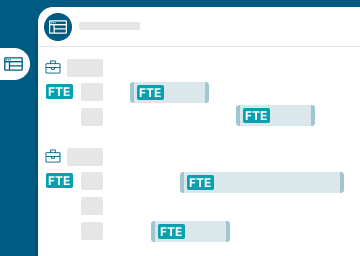Baseball season is back. And if you're anything like me, watching those first few games gets you thinking about teams: how they're built, managed, and what makes them click.
I've noticed some parallels between what happens on the pitch and what we do every day in resource management. So, I chatted with Kathleen Fitzgerald from Linked Workforce to see if I was onto something.
Planning your season (and being ready to change it)

Just like baseball managers, resource managers can’t afford to ‘wing it’. Baseball teams spend months carefully planning their lineup, rotation, and game strategies to maximise performance. In the same way, annual planning is essential for resource managers. As Kathleen puts it, an annual planning process is critical for effective capacity and demand planning—it provides the data, insights, and structure needed to ensure organisations have the right workforce in place to deliver on strategic goals and project demands.
This makes sense right? But here's the reality check – even the best plans go awry. Your star resource calls in sick. A project unexpectedly goes into extra innings. You know how it goes.
"Resource Managers will need to continue to be nimble and address game-day staffing changes," Kathleen says. "Things happen... someone may be out sick, there may need to be a replacement because the person you had expected to start a project has to work extra hours on their current engagement (think of going into extra innings for an example). Planning ahead is critical but being able to react to and address immediate demands is part of the game."
That's why so many resource planners find traditional spreadsheets so frustrating. Try making quick changes when you're juggling different Excel files with information that may be incomplete or inaccurate. With Retain, we've focused on making both the long-term planning and those day-to-day adjustments much less painful.
We've got a lot of content to support you with this step. Here are our favourite articles:
- Beyond Excel for resource planning
- Outgrown Excel? Here’s how to move to a specialist resource management system
- 5 expert tips + free resource plan Excel template
It's not just about who's available

You’ve probably seen it too many times – project staffing becomes a matter of "who's free right now" rather than "who's right for this job."
Kathleen nodded when I brought this up. "There's a lot more than just availability that goes into assembling the best team," she explained. "It's important for Resource Managers to consider a number of different factors when confirming resources."
Some critical factors she mentioned:
- Resource level and cost
- Overall team makeup and leverage
- Skills and experience
- Personal interests ("does it ideally align with what the employee wants to work on?")
- Performance history
- Project complexity and risk
- Location and time zone considerations
It reminds me of baseball managers who consider how a player performs against certain pitchers, in certain ballparks, in day games versus night games.
Continue reading: Skills based resource allocation: match talent to the right projects
The chemistry factor
You've probably seen this before – a team that looks amazing on paper but just doesn't gel. Meanwhile, a seemingly average team outperforms everyone because they work together brilliantly.
"Each of us has our own unique personality and work style," Kathleen explained.
"Understanding and embracing these differences can dramatically improve team performance."
She described how behavioural profiling helps: "Individuals learn more about their communication preferences and how they like to get work done; what motivates them and how they handle stressful situations. They also learn this information about their teammates."
The impact can be huge: "By understanding each other better and working in a way that brings out the best in each other, the team overall is able to produce at a much higher level."
This is why we've put so much emphasis on team chemistry tools at Retain. The right mix of personalities and work styles can be as important as the right mix of skills.
Continue reading: Behavioural skills vs technical skills: why resource planning needs both
Your specialist relief pitchers

I love this analogy. Just as baseball teams have specialist relievers for specific situations, most organisations have those go-to experts for specialised tasks.
"The first step is for Resource Managers to clearly understand the skillset of the Specialist," Kathleen advises. "Exactly what work do they do? What sets them apart from other professionals in their group? How should they be utilised on projects?"
She continued with practical advice: "It will be important for Resource Managers to identify projects (and likely small portions of projects) that truly need and will utilise their specialised skillset. They should ensure that the Project Manager is aware and onboard for the specialist to focus on their area of expertise."
Kathleen likens it to baseball strategy: "Think of a specialised relief pitcher who is brought in to address a specific need (they have a skillset best suited to handle the upcoming batter for example)."
She also emphasised ongoing communication: "Resource Managers should stay close to their specialists... ensure they are being utilised appropriately, that their workload is reasonable. Keep the lines of communication open. Provide the support they need for them to stay at the top of their game."
Continue reading: Guide to skills-based resource allocation
Trying out different line-ups

"What would happen if we moved this person here and adjusted that timeline?" That's the kind of scenario planning baseball managers do constantly.
With Retain, you can model different team configurations before making final decisions. See how changes might affect timelines, budgets, or team dynamics. It's like having a baseball manager's ability to visualise different lineup possibilities before filling out the lineup card.
You know how it goes – you've got a potential team in mind, but you're not sure if it's the optimal configuration. Maybe you're wondering if your senior developer could handle two projects simultaneously or if bringing in that specialist consultant would speed things up enough to justify the cost. Retain's scenario planning capabilities let you play these "what-if" games with real data behind them. You can quickly test multiple approaches, see utilisation impacts across your entire resource pool, and make informed decisions rather than going with your gut.
Continue reading: 6 techniques for effective resource forecasting
Learning from the game tape
Baseball teams obsessively review game footage. They're constantly learning and adjusting based on what worked and what didn't.
Post-project reviews provide invaluable data on which resource combinations worked well, which individuals thrived in certain roles, and where things went sideways – giving you actionable insights for next time.
It’s surprising how many skip this step. They wrap up a project and immediately move on to the next one without taking time to analyse what happened. It's like a baseball team never watching their game tapes!
Retain makes this reflection process much easier by capturing the data you need for meaningful reviews. You can see patterns that might otherwise go unnoticed – like which project manager consistently brings projects in under budget or how certain team combinations consistently outperform expectations.
Keeping your eye on the scoreboard

Just like baseball managers constantly check stats during a game, resource managers need real-time visibility into key metrics.
"Resource Managers are likely looking at employee's scheduled hours, utilisation and performance on a pretty regular basis and identify and addressing issues" Kathleen explains. "This includes employees who are working too much overtime and/or have YTD utilisation that is too high or professionals on the other end - those who don't have enough work."
She emphasises proactive monitoring: "Resource Managers will also constantly keep their pulse on overall scheduled hours utilisation to plan, availability etc. It is up to them to proactively identify and address demand/capacity fluctuations and issues."
With the right dashboards, you can spot overallocation before it leads to burnout, or identify bench time that could be better utilised.
Continue reading: Professional services at breaking point: the 2025 burnout crisis
Growing your farm system
Baseball teams invest heavily in player development. The best organizations look beyond today's needs to build tomorrow's stars.
"Think about players who get drafted and who need training and practice to develop," Kathleen suggests. "They spend countless hours working with different coaches, learning new techniques and just practicing over and over. All of this happens long before their first game and is ongoing, once they've made it to the big leagues." Practice and ongoing training is critical for players to further develop and maintain their craft."
She acknowledges the tension between billable work and development: "Sometimes they need to practice outside of the game. This ongoing investment is critical for managers and companies to ensure their teams are best prepared for the games ahead."
Her bottom line: "While billable work is critical for the ongoing financial health of a company, making an investment into the ongoing development of your people is also incredibly important if they are to stay at the top of their game."
Continue reading: Maximise billable hours: a guide for professional services firms
Creating a winning culture
Finally, we talked about team culture – that intangible but crucial element that defines winning organisations.
"Project Managers will have insight into the overall team dynamics and will be able to create a more collaborative environment," Kathleen explains. "They will also be able to tailor their management approach to each employee, providing them the support they need to thrive."
The benefits are substantial: "When team members understand and appreciate each other's strengths and weaknesses, they are also more likely to support one another, building stronger team bonds. Team members will feel a part of something and work hard to ensure the success of the project."
And the impact on retention is clear: "All of this improves morale and satisfaction which reduces job stress, burnout and turnover."
Ready to play ball?
So there you have it – baseball's playbook for better resource management. Whether you're dealing with curveballs from clients or trying to develop your rookie talent, the principles are surprisingly similar.
Want to see how Retain can help your team hit it out of the park? Let's talk.

